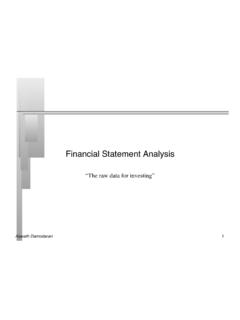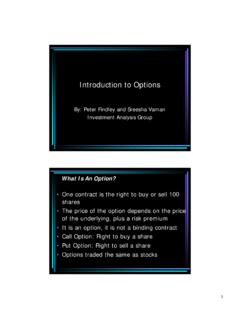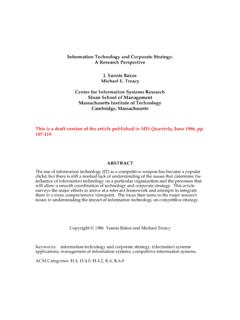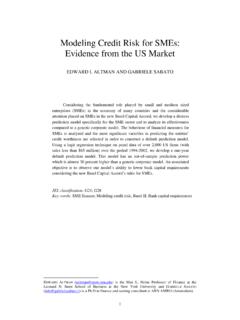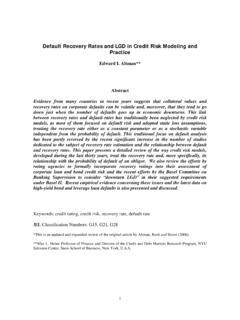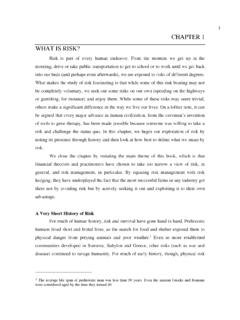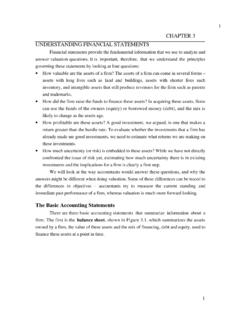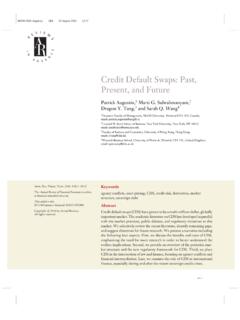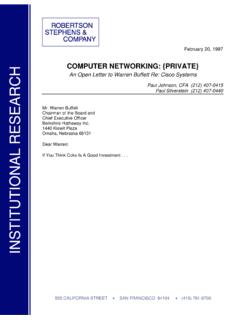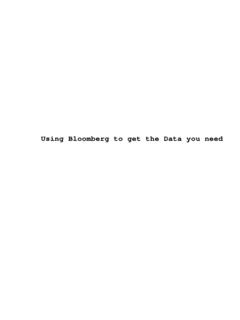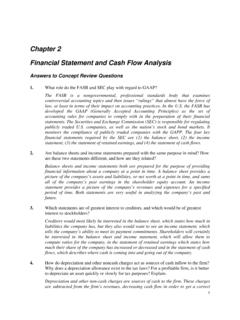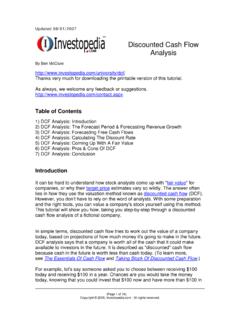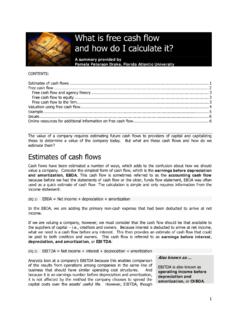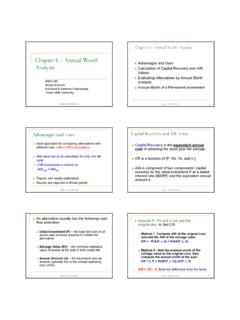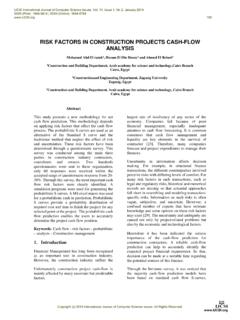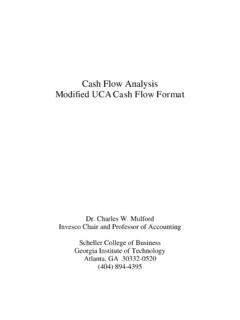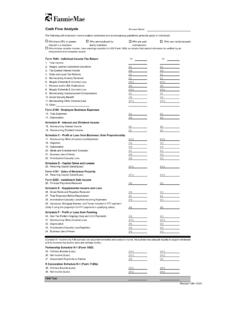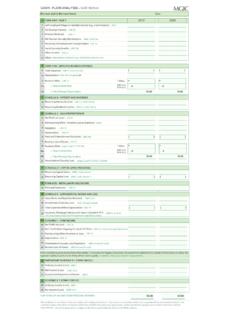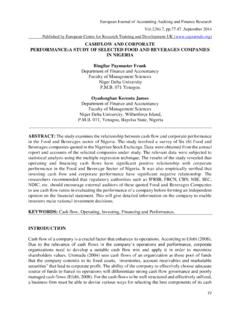Transcription of Discounted Cash Flow Valuation: The Inputs
1 1 Discounted cash flow valuation : Discounted cash flow valuation : The InputsThe InputsAswath Damodaran2 The Key Inputs in DCF ValuationThe Key Inputs in DCF ValuationlDiscount Rate Cost of Equity, in valuing equity Cost of Capital, in valuing the firmlCash flows Cash flows to Equity Cash flows to FirmlGrowth (to get future cash flows ) Growth in Equity Earnings Growth in Firm Earnings (Operating Income)3I. Estimating Discount RatesI. Estimating Discount RatesDCF Valuation4 Estimating Inputs : Discount RatesEstimating Inputs : Discount RateslCritical ingredient in Discounted cashflow valuation . Errors in estimating the discount rate or mismatching cashflows and discount rates can lead to serious errors in valuation . lAt an intuitive level, the discount rate used should be consistent with both the riskiness and the type of cashflow being Discounted .
2 Equity versus Firm: If the cash flows being Discounted are cash flows to equity, the appropriate discount rate is a cost of equity. If the cash flows are cash flows to the firm, the appropriate discount rate is the cost of capital. Currency: The currency in which the cash flows are estimated should also be the currency in which the discount rate is estimated. Nominal versus Real: If the cash flows being Discounted are nominal cash flows ( , reflect expected inflation), the discount rate should be nominal5I. Cost of EquityI. Cost of EquitylThe cost of equity is the rate of return that investors require to make an equity investment in a firm. There are two approaches to estimating the cost of equity; a dividend-growth model. a risk and return modellThe dividend growth model (which specifies the cost of equity to be the sum of the dividend yield and the expected growth in earnings) is based upon the premise that the current price is equal to the value.
3 It cannot be used in valuation , if the objective is to find out if an asset is correctly risk and return model, on the other hand, tries to answer two questions: How do you measure risk? How do you translate this risk measure into a risk premium?6 What is Risk?What is Risk?lRisk, in traditional terms, is viewed as a negative . Webster s dictionary, for instance, defines risk as exposing to danger or hazard . The Chinese symbols for risk are reproduced below:lThe first symbol is the symbol for danger , while the second is the symbol for opportunity , making risk a mix of danger and opportunity. 7 Risk and Return ModelsRisk and Return ModelsThe risk in an investment can be measured by the variance in actual returns around an expected returnE(R)Riskless InvestmentLow Risk InvestmentHigh Risk InvestmentE(R)E(R)Risk that is specific to investment (Firm Specific)Risk that affects all investments (Market Risk)Can be diversified away in a diversified portfolio Cannot be diversified away since most assets1.
4 Each investment is a small proportion of portfolioare affected by risk averages out across investments in portfolioThe marginal investor is assumed to hold a diversified portfolio. Thus, only market risk will be rewarded and CAPMThe APMM ulti-Factor ModelsProxy ModelsIf there is 1. no private information2. no transactions costthe optimal diversified portfolio includes everytraded asset. Everyonewill hold this market portfolioMarket Risk = Risk added by any investment to the market portfolio:If there are no arbitrage opportunities then the market risk ofany asset must be captured by betas relative to factors that affect all Risk = Risk exposures of any asset to market factorsBeta of asset relative toMarket portfolio (froma regression)Betas of asset relativeto unspecified marketfactors (from a factoranalysis)Since market risk affectsmost or all investments,it must come from macro economic Risk = Risk exposures of any asset to macro economic of assets relativeto specified macroeconomic factors (froma regression)In an efficient market,differences in returnsacross long periods mustbe due to market riskdifferences.
5 Looking forvariables correlated withreturns should then give us proxies for this Risk = Captured by the Proxy Variable(s)Equation relating returns to proxy variables (from aregression)Step 1: Defining RiskStep 2: Differentiating between Rewarded and Unrewarded RiskStep 3: Measuring Market Risk8 Comparing Risk ModelsComparing Risk ModelsModelExpected ReturnInputs NeededCAPME(R) = Rf + (Rm- Rf)Riskfree RateBeta relative to market portfolioMarket Risk PremiumAPME(R) = Rf + j=1 j (Rj- Rf)Riskfree Rate; # of Factors;Betas relative to each factorFactor risk premiumsMulti E(R) = Rf + j=1,,N j (Rj- Rf)Riskfree Rate; Macro factorsfactorBetas relative to macro factorsMacro economic risk premiumsProxyE(R) = a + j= bj YjProxiesRegression coefficients9 Beta s PropertiesBeta s PropertieslBetas are standardized around = Average risk investment > Above Average risk investment < Below Average risk investment = Riskless investmentlThe average beta across all investments is of the CAPML imitations of the CAPMl1.
6 The model makes unrealistic assumptionsl2. The parameters of the model cannot be estimated precisely - Definition of a market index - Firm may have changed during the 'estimation' period'l3. The model does not work well - If the model is right, there should be l* a linear relationship between returns and betasl* the only variable that should explain returns is betas - The reality is thatl* the relationship between betas and returns is weak l* Other variables (size, price/book value) seem to explain differences in returns required to use the CAPM - Inputs required to use the CAPM - (a) the current risk-free rate(b) the expected return on the market index and (c) the beta of the asset being analyzed. 12 Riskfree Rate in ValuationRiskfree Rate in ValuationlThe correct risk free rate to use in a risk and return model isoa short-term Government Security rate (eg.)
7 , since it has no default risk or price riskoa long-term Government Security rate, since it has no default riskoother: specify -> 13 The Riskfree RateThe Riskfree RatelOn a riskfree asset, the actual return is equal to the expected , there is no variance around the expected an investment to be riskfree, , to have an actual return be equal to the expected return, two conditions have to be met There has to be no default risk, which generally implies that the security has to be issued by the government. Note, however, that not all governments can be viewed as default free. There can be no uncertainty about reinvestment rates, which implies that it is a zero coupon security with the same maturity as the cash flow being Rate in PracticeRiskfree Rate in PracticelThe riskfree rate is the rate on a zero coupon government bond matching the time horizon of the cash flow being , this translates into using different riskfree rates for each cash flow - the 1 year zero coupon rate for the cash flow in year 2, the 2-year zero coupon rate for the cash flow in year 2.
8 LPractically speaking, if there is substantial uncertainty about expected cash flows , the present value effect of using time varying riskfree rates is small enough that it may not be worth Bottom Line on Riskfree RatesThe Bottom Line on Riskfree RateslUsing a long term government rate (even on a coupon bond) as the riskfree rate on all of the cash flows in a long term analysis will yield a close approximation of the true short term analysis , it is entirely appropriate to use a short term government security rate as the riskfree the analysis is being done in real terms (rather than nominal terms) use a real riskfree rate, which can be obtained in one of two ways from an inflation-indexed government bond, if one exists set equal, approximately, to the long term real growth rate of the economy in which the valuation is being Rate in ValuationRiskfree Rate in ValuationlYou are valuing a Brazilian company in nominal dollars.
9 The correct riskfree rate to use in this valuation is:othe treasury bond rateothe Brazilian C-Bond rate (the rate on dollar denominated Brazilian long term debt)othe local riskless Brazilian Real rate (in nominal terms)othe real riskless Brazilian Real rate17 Measurement of the risk premiumMeasurement of the risk premiumlThe risk premium is the premium that investors demand for investing in an average risk investment, relative to the riskfree a general proposition, this premium should be greater than zero increase with the risk aversion of the investors in that market increase with the riskiness of the average risk investment18 Risk Aversion and Risk PremiumsRisk Aversion and Risk PremiumslIf this were the capital market line, the risk premium would be a weighted average of the risk premiums demanded by each and every weights will be determined by the magnitude of wealth that each investor has.
10 Thus, Warren Bufffet s risk aversion counts more towards determining the equilibrium premium than yours and investors become more risk averse, you would expect the equilibrium premium to Risk Premiums in PracticeEstimating Risk Premiums in PracticelSurvey investors on their desired risk premiums and use the average premium from these that the actual premium delivered over long time periods is equal to the expected premium - , use historical datalEstimate the implied premium in today s asset Survey ApproachThe Survey ApproachlSurveying all investors in a market place is , you can survey a few investors (especially the larger investors) and use these results. In practice, this translates into surveys of money managers expectations of expected returns on stocks over the next limitations of this approach are: there are no constraints on reasonability (the survey could produce negative risk premiums or risk premiums of 50%) they are extremely volatile they tend to be short term.
